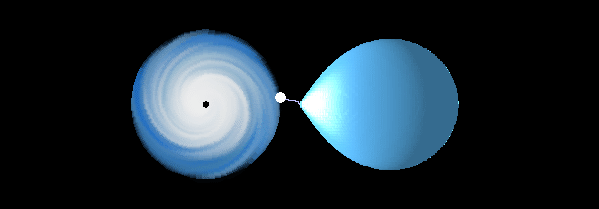Accretion Disks in Binary Star Systems
|

|
In many binary star systems, the primary star is a compact object
such as a black hole, a neutron star, or white dwarf. If the objects
are close enough, and the secondary star is a non-degenerate star, the
secondary star is tidally distorted and mass transfer is initiated.
Matter is lost through the first Lagrange point and flows towards the
more massive compact object. Eventually this mass builds up to form
an accretion disk. The event detection capability of NDSolve is used to
show the path of the mass transfer stream up to the point that it impacts
the accretion disk. The location of the impact point is important
because increased heating and brightening of the accretion disk occur
at this point. This can have drastic implications on the photometric
light curve of an accretion disk, causing one side to appear brighter
than the other, especially in eclipsing systems. The animation below
shows how the impact point moves in relation to the accretion disk with a
varying radius. All other system parameters are held constant. For an
artist's rendition of one of these systems, see
Astronomy Picture
of the Day.
View Varying Radius | View Eclipsing System

Mathematica generated animation showing the impact point of the mass transfer stream for varying accretion disk radii. Animation created by Jeff Bryant (jeffb@wolfram.com). Spiral image texture created by Waylena McCully.
|


